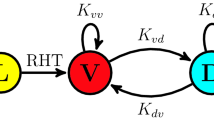Abstract
Dark motility was measured by means of an infrared beam in stationary, 8- to 10-months-old autotrophic cultures ofEuglena gracilis, strain Z. Controls in constant darkness exhibited circadian rhythms for several weeks. Cells were subjected to series of short light pulses of 800 lx covering, in most of the experiments, not more than 1/240 of the intermittent dark periods. When the overall amount of light per day was kept constant, the results of the light treatment strongly depended on the frequency of the light pulses. In light/dard cycles of more than 1 h, the circadian rhythmicity persited, whereas the oscillator was affected by cycles of 40 min or less. Such treatment by a high-frequency series of light pulses led to long-term fluctuations lasting for several days and a subsequent holding of the oscillator. The temporal position of extreme values of the fluctuations correlated with the frequency of the light pulses. The potency of light to suppress rhythmicity, as known from fading-out phenomena in constant illumination, is not restricted to the continuous presence of light, but is also immanent in the Zeitgeber signals of dark/light transitions. Hence, the results reflect differential effects in the action of light.
Similar content being viewed by others
References
Aschoff J (1960) Exogenous and endogenous components in circadian rhythms. Cold Spring Harbor Symp Quant Biol. 25:11–28
Aschoff J (1965) Response curves in circadian periodicity. In: Aschoff J (ed) Circadian clocks. North Holland, Amsterdam, pp 95–111
Balzer I, Hardeland R (1988) Influence of temperature on biological rhythms. Int J Biometeorol 32:231–241
Balzer I, Hardeland R (1990) Circadian rhythm of dark motility inEuglena: transition to arrhythmicity by series of short light pulses. Interdiscipl Cycle Res 21:168–169
Balzer I, Neuhaus-Steininetz U, Quentin E, van Wüllen M, Hardeland R (1989) Concomitance of circadian and circa-4-hour ultradian rhythms inEuglena gracilis. J Interdiscipl Cycle Res 20:15–24
Bünning E (1973) The physiological clock. Springer, New York Heidelberg Berlin
Daan S, Pittendrigh CS (1976a) A functional analysis of circadian pacemakers in nocturnal rodents. II. The variability of phase response curves. J Comp Physiol [A] 106:253–266
Daan S, Pittendrigh CS (1976b) A functional analysis of circadian pacemakers in nocturnal rodents III. Heavy water and constant light: homeostasis of frequency? J Comp Physiol [A] 106:267–290
Hardeland R, Balzer I (1988) The cellular circadian oscillator—A fundamental biological mechanism corresponding to a geophysical periodicity. Int J Biometeorol 32:149–162
Hardeland R, Nord P (1984) Visualization of free-running circadian rhythms in the linoflagellatePyrocystis noctiluca Marine Behav Physiol 11:199–207.
Neuhans-Steinmetz U, Balzer I, Hardeland R (1990) Ultradian rhythmicity of tyrosine aminotransferase activity inEuglena gracilis: Analysis by cosine and non-sinusoidal fitting procedures. Int J Biometeorol 34:28–34
Pittendrigh CS (1965) On the mechanism of the entraiment of a circadian rhythm by light cycles In: Aschoff J (ed) Circadian clocks. North Holland, Amsterdam, pp. 277–297
Pittendrigh CS, Daan S (1976) A functional analysis of circadian pacemakers in nocturnal rodents. IV. Entrainment: pacemaker as clock. J Comp Physiol [A] 106:291–331
Pittendrigh CS, Minis DH (1971) The photoperiodic time measurement inPectinophora gossypiella and its relation to the circadian system in that species. In: Menaker M (ed) Biochronometry. National Academy of Science, Washington, pp 212–250
Quentin E (1984) Zur Frage der Interaktion von Proteinsynthese und Membranfluidität im circadianen Oszillator vonEuglena dracilis. Doctoral Thesis, University of Göttingen
Schnabel G (1968) Der Einfluß von Licht auf die circadiane Rhythmik vonEuglena gracilis bei Autotrophie und Mixotrophie. Planta 81:49–63
Author information
Authors and Affiliations
Additional information
Manuscript of oral presentation given at the 12th International Congress of Biometeorology
Rights and permissions
About this article
Cite this article
Balzer, I., Hardeland, R. Differential light effects on the dark motility rhythm inEuglena gracilis by series of short light pulses: Induction of long-term fluctuations and holding of the circadian oscillator. Int J Biometeorol 34, 235–238 (1991). https://doi.org/10.1007/BF01041835
Received:
Revised:
Accepted:
Issue Date:
DOI: https://doi.org/10.1007/BF01041835




